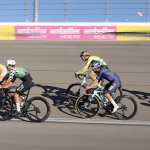Gildan Activewear Inc., which is the largest supplier of branded athletic socks in the United States, reported record fourth quarter adjusted earnings per share of $1.00, up 20.5 percent compared to last year, but projected a loss for the upcoming quarter due to price cuts it took to preserve market share in its printable apparel business.
The company, which is the exclusive sock licensee for Under Armour, New Balance and Mossy Oak, reported net sales grew 6.4 percent to $666.0 million, in the fourth quarter ended Oct. 5 compared with the same period a year ago. Net earnings in the fourth quarter of fiscal 2014 were $122.7 million, or $1.00 per share on a diluted basis, compared with net earnings of $96.8 million, or $0.79 per share, for the fourth quarter of fiscal 2013.
There were essentially no adjustments to net earnings in the fourth quarter of fiscal 2014. Adjusted net earnings were $122.8 million or $1.00 per share for the fourth fiscal quarter ended Oct. 5, 2014, up 20.4 percent and 20.5 percent respectively compared with adjusted net earnings of $102.0 million or $0.83 per share before reflecting restructuring and acquisition-related costs and a charge for unwinding interest rate swaps in the fourth quarter of the previous year.
EPS for the fourth quarter represent a record performance for any fiscal quarter in the company’s history. The growth in adjusted net earnings and EPS in the fourth quarter compared to last year was due to higher sales in both operating segments, including the impact of the acquisition of Doris, combined with lower income tax and financial expenses. The growth in consolidated net sales in the fourth quarter was due to increased sales of branded underwear and activewear in Branded Apparel, higher Printwear sales and the impact of the acquisition of Doris. Gildan also is a licensed manufacturer for specific Mossy Oak products, including underwear and thermal underwear, lounge wear, graphic T-shirts, fleece and blankets.
The company had most recently projected adjusted EPS of $1.06 – $1.09 on projected sales revenues in excess of $700 million. The lower than previously projected sales and earnings growth in the fourth quarter was primarily due to lower than projected sales growth in Branded Apparel. Sales of Gildan branded products in the quarter were up by more than 35 percent and the company continued to gain market share in men’s underwear. However, sales to retailers in all product categories were lower than projected due to inventory destocking by retailers, the delayed timing of fleece programs which the company serviced in October, and weaker than anticipated market demand. The company is now experiencing strong replenishment orders in the December quarter.
In spite of the impact of inflationary cost increases and continuing transitional manufacturing inefficiencies related to the integration of new retail products, consolidated gross margins in the fourth quarter of fiscal 2014 were 28.8 percent, up from 28.3 percent in the fourth quarter last year. The improvement in consolidated gross margins was primarily due to more favourable product-mix in both operating segments, higher net selling prices in Printwear compared to last year and the impact of the acquisition of Doris. Cotton costs in the fourth quarter of fiscal 2014 were essentially comparable to cotton costs in the fourth quarter of last year.
SG&A expenses in the fourth quarter were $72.2 million, compared with $69.7 million in the fourth quarter of last year. The increase in SG&A expenses was due to the acquisition of Doris. SG&A expenses excluding the impact of the Doris acquisition were slightly down compared to last year mainly due to lower variable compensation expenses, partially offset by higher advertising expenses. Excluding the impact of Doris, SG&A expenses as a percentage of sales in the fourth quarter of fiscal 2014 were 10.5 percent compared to 11.1 percent a year ago.
Income taxes in the fourth quarter of fiscal 2014 decreased compared to the same period last year as a result of the recognition of a tax benefit following the acquisition of Doris, as well as a year-to-date true-up adjustment to the income tax provision as a result of lower than projected sales for Branded Apparel in the fourth quarter.
During the fourth quarter of fiscal 2014, the company generated $112.5 million of free cash flow, after financing capital expenditures of $73.3 million. For fiscal 2014, the company utilized $23.7 million of cash after financing working capital increases and capital expenditures of $292.7 million. As a result of lower than forecast shipments in Branded Apparel in the fourth quarter, inventory levels at the end of the fourth quarter were approximately $50 million higher than planned. During fiscal 2014, the company essentially completed its capital investments for the refurbishment of Rio Nance I, the upgrade of the former Anvil textile facility, the Honduras distribution centre and the new Salisbury, North Carolina, ring-spun yarn-spinning facility. The company ended the fiscal year with cash and cash equivalents of $65.2 million and outstanding bank indebtedness of $157.0 million.
Fourth Quarter Segmented Results
Net sales for the Printwear segment in the fourth quarter of fiscal 2014 amounted to $435.8 million, up 2.8 percent from $423.9 million in the fourth quarter of fiscal 2013. The increase in Printwear net sales was due to higher net selling prices in the quarter and more favourable product-mix, partially offset by weaker demand.
In the fourth quarter, the Printwear segment reported operating income of $118.9 million, up 6.2 percent from $112.0 million in the fourth quarter of fiscal 2013. Operating margins for Printwear were 27.3 percent, compared with 26.4 percent in the fourth quarter of last year due to higher net selling prices and more favourable product-mix.
Net sales for Branded Apparel were $230.2 million, up 13.8 percent from $202.2 million in the fourth quarter of last year mainly due to increased sales of underwear and activewear and the acquisition of Doris, partially offset by lower sock sales. Sales of underwear were up by approximately 60 percent, in spite of a high level of promotional activity from other national brands during the back-to-school period. During the three-month period ended September 30, 2014, the Gildan brand remained in the no.3 position in men’s underwear and achieved a market share of 7.5 percent in the month of September, according to the NPD Group’s Retail Tracking Service. The lower sales of socks compared to last year was entirely due to lower sales of private label and our decision to exit from a licensing arrangement. Gold Toe men’s and ladies socks continued the upward trend of gaining market share. Sales to retailers in all product categories were impacted by retailer inventory destocking.
The Branded Apparel segment reported quarterly operating income of $22.5 million, up 24.3 percent compared with $18.1 million in the fourth quarter of fiscal 2013. Operating margins were 9.8 percent, compared to 8.9 percent a year ago. The increase in operating margins for Branded Apparel reflected more favourable product-mix and the impact of the acquisition of Doris. These factors more than offset inflationary cost increases and the impact of continued transitional manufacturing inefficiencies incurred to support the introduction of new retail products.
Year-to-date Sales and Earnings
Consolidated net sales revenues for fiscal 2014 amounted to $2,360.0 million, up 8.0 percent from $2,184.3 million in fiscal 2013 reflecting sales growth in all product categories. The increase was primarily attributable to higher unit sales volumes and more favourable product-mix in both operating segments, higher net selling prices in Printwear and the acquisition of Doris which contributed approximately $20 million of sales revenues.
Net earnings for fiscal 2014 were $359.6 million or $2.92 per share on a diluted basis, compared to $320.2 million or $2.61 per share for fiscal 2013. Before reflecting restructuring and acquisition-related costs in both years and the charge for unwinding interest rate swaps in fiscal 2013, adjusted net earnings amounted to $362.0 million or $2.94 per share, up 9.6 percent and 9.3 percent respectively compared to $330.3 million or $2.69 per share in fiscal 2013. The increase in net earnings was mainly due to increased sales in Printwear and Branded Apparel, lower income taxes and financial expenses, partially offset by higher manufacturing costs due primarily to the impact of inflationary cost increases, transitional manufacturing costs to upgrade the company’s manufacturing operations and support future growth, and higher cotton costs.
Change in Fiscal Year-End
The company announced that it will be transitioning to a new fiscal year-end in 2015. As a result of this transition, the company’s year-end will take place on the Sunday closest to December 31, rather than the first Sunday following September 28. The change in year-end recognizes that the seasonality of the overall consolidated sales revenues for the company is changing due to the increasing importance of the Branded Apparel segment. The company’s business planning cycle is becoming more aligned with the calendar year, and this change will provide better visibility on retail program placements and cotton fixations. In addition, the change in year-end will be better aligned with Gildan’s industry comparables.
For purposes of its regulatory filings, the company will report results for the 15-month transition period beginning Oct. 6, 2014 and ending January 3, 2016. The company’s first 12-month fiscal year on a calendar basis will begin on January 4, 2016 and end on January 1, 2017. The company is providing sales and earnings guidance for the 3-month period ending January 4, 2015 and for the 12-month period ending January 3, 2016. The company has also provided supplemental financial information on its website containing recast historical financial information for 2011 to 2013 on a calendar year basis. Recast financial statements for calendar 2014 will be available on the company’s website following the company’s earnings release for the quarter ending January 4, 2015.
Strategic Pricing Actions in Printwear
The company has decided to take major strategic pricing actions in Printwear to reinforce its leadership position in the industry. The company has decided to significantly lower base selling prices and reduce and simplify its discount structure, in order to be responsive to distributors and enhance their ability and visibility to plan their business. In addition, these strategic pricing actions will reinforce its industry leadership position and stimulate end-use demand, in order to drive unit sales volume and earnings growth in calendar 2015 and beyond. The company has historically followed a strategy to continue to invest in low-cost manufacturing capacity and cost reduction projects and pass through a portion of the resulting cost reductions into lower selling prices. The selling price reductions reflect the pass-through of a portion of the expected cost savings from the company’s investments in new yarn-spinning facilities into lower selling prices, in order to drive further growth and market penetration. The price reductions also reflect the further reduction in the price of cotton futures in recent months.
The company will be applying the benefit of the reduction in selling prices announced on December 3, 2014 to existing distributor inventories in the form of a distributor inventory devaluation discount projected to be approximately $45 million, which will be reflected as a deduction from sales in the 3-month period ending January 4, 2015.
Outlook for the 3-Month Period Ending January 4, 2015
As a result of these pricing actions the company is currently projecting a net loss of approximately $0.30 per share on projected sales revenues of approximately $400 million for the 3-month period ending January 4, 2015, compared with adjusted EPS of $0.35 and sales revenues of $451.4 million in the corresponding calendar quarter of 2013. Sales revenues for Printwear are expected to decline compared to the corresponding quarter of last year, due to the impact of the distributor inventory devaluation and distributor destocking in the quarter. Slightly higher than normal distributor destocking in the month of December is anticipated due to the change in the incentive structure. The December quarter is normally the lowest sales quarter of the year for T-shirts.
The company is projecting strong organic sales growth in Branded Apparel for the quarter ending January 4, 2015 in addition to the impact of the acquisition of Doris. The projected organic growth is due to new programs and the resumption of inventory replenishment by retailers after the retailer inventory destocking which impacted sales in the fourth quarter of fiscal 2014 and continued in the beginning of the current quarter. However, results for Branded Apparel in the quarter are projected to be negatively impacted by the consumption of inventories produced during fiscal 2014 which include the impact of transitional inefficiencies in the manufacturing of retail products. In addition, higher brand marketing and advertising expenses in Branded Apparel are projected in the quarter ending January 4, 2015 to support holiday sales programs. Margins in both operating segments are projected to be negatively impacted by slightly higher cotton costs than the corresponding quarter of last year.
Outlook For the 12-Months Ending January 3, 2016
For the 12-months ending January 3, 2016, the company’s initial guidance is for adjusted EPS of $3.00 – $3.15, on sales of close to U.S $2.65 billion, compared to adjusted EPS of $2.94, on sales of $2.36 billion in fiscal 2014. The company is projecting Printwear sales growth for calendar 2015 of approximately 3 percent compared to fiscal 2014. Sales revenues for Branded Apparel are projected to increase by approximately 30 percent compared to fiscal 2014. Adjusted EBITDA for the year is projected to be approximately $525 – $545 million.
Compared to fiscal 2014, the projected growth in EPS in calendar 2015 is due to projected sales volume growth in both operating segments, lower manufacturing costs resulting from capital investment projects, and declining cotton costs in the second half of the calendar year. These positive factors are projected to be largely offset by the impact of lower Printwear selling prices, higher SG&A expenses including the impact of increased investment in brand advertising and marketing, inflationary cost increases and higher income taxes.
The following provides more detail on some of the above assumptions underlying the company’s guidance for the 12-months ending January 3, 2016 compared to fiscal 2014:
- Strong Printwear unit volume growth is assumed due to the company’s strategic pricing actions which are expected to result in improved end-use demand and increased market share, partially offset by a lower number of shipping days compared to fiscal 2014. Strong growth is also assumed in international markets.
- Projected sales revenue for Branded Apparel in calendar 2015 include the annualized impact of new programs obtained in fiscal 2014 and only those new programs for calendar 2015 which have been confirmed.
- The EPS impact of lower Printwear net selling prices in calendar 2015 is projected to be approximately $0.70. No change is assumed in selling prices in Branded Apparel.
- The EPS benefit of lower cotton costs in calendar 2015, compared to fiscal 2014, is projected to be approximately $0.35. Because of the high level of opening inventories, it will take longer than previously planned to consume high-cost cotton. Gildan will not fully benefit from current low cotton futures until the fourth quarter of calendar 2015.
- Manufacturing efficiencies resulting from capital investments projects are projected to be partially offset by inflationary cost increases and the consumption of inventories produced during fiscal 2014 which include the impact of transitional inefficiencies in the manufacturing of retail products. The net positive effect of these factors on EPS is projected to be $0.20 in calendar 2015. The company is on track to achieve its projected 3-year target of $100 million in annual cost savings from its major capital investment projects. The company’s new yarn-spinning facilities are projected to be in operation by the end of calendar 2015, and further benefit results in calendar 2016.
- As a percentage of consolidated sales revenues, SG&A expenses in calendar 2015 are expected to be comparable to fiscal 2014. Volume leverage in Branded Apparel is assumed to be offset by increased investments in brand marketing and advertising, and the impact of the Doris acquisition.
- The projected effective income tax rate in calendar 2015 is approximately 4.5 percent.
- The company’s guidance assumes no material change in the current economic environment including the continuation of current soft retail market conditions.
Earnings for the first half of calendar 2015 are expected to be comparable or slightly lower than the first half of calendar 2014, as the positive impact of unit sales growth in Printwear and sales growth in Branded Apparel are projected to be offset by margin pressure as a result of lowering Printwear selling prices before the company has completed the ramp-up of its yarn-spinning investments and while the company continues to consume higher-cost cotton. Earnings growth is projected in the second half of calendar 2015, compared to the second half of calendar 2014, due to the impact of unit volume growth, manufacturing cost reductions and declining cotton costs.
The earnings momentum in the fourth calendar quarter of 2015 is expected to position the company for earnings growth in calendar 2016. The company expects to benefit in calendar 2016 from continuing volume growth and further significant manufacturing efficiencies, including the benefit of ramping up the company’s new yarn-spinning facilities. In addition, the company currently expects that Printwear selling prices will continue to be in better alignment with cotton costs.
Gildan is a leading supplier of quality branded basic family apparel, including T-shirts, fleece, sport shirts, underwear, socks, hosiery and shapewear. The company sells its products under a diversified portfolio of company-owned brands, including the Gildan , Gold Toe and Anvil brands and brand extensions, as well as the recently acquired Secret , Silks and Therapy Plus brands. The company also has licenses for the Under Armour , Mossy Oak , and New Balance brands. The company distributes its products in printwear markets in the and Canada, as well as in Europe, Asia Pacific and Latin America. The company also markets its products to a broad spectrum of retailers in the and Canada.
The company owns and operates vertically-integrated, large-scale manufacturing facilities which are primarily located in Central America and the Caribbean Basin to efficiently service the replenishment needs of its customers in the printwear and retail markets. Gildan has over 43,000 employees worldwide and is committed to industry-leading labour and environmental practices in all of its facilities.















